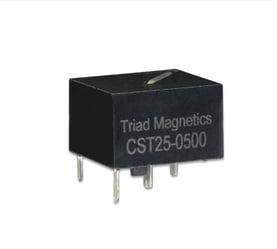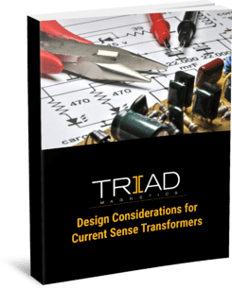Current transformers (CTs)—also known as current sense transformers or current sensors—are instruments that are designed and manufactured to detect electrical currents and convert them into more usable forms for different applications. They perform these detections and conversions by measuring the larger current value in the primary winding and developing a corresponding smaller current in the secondary winding.
CTs can be classified into three categories based on how accurately they detect current across a specific range: high-precision, medium-precision, and low-precision. Since each is suitable for different current detection and/or control applications, it is important to ensure the transformer chosen for an application suits the precision requirements. Otherwise, you risk overpaying for the system or the system underperforming. That’s why transformers are often designed with the specific application in mind.
There are many elements to consider when specifying a current transformer, which can make the process seem difficult or challenging. Below, we highlight some of the key factors to keep in mind to better understand the design process.
Turns Ratio

Turns ratio—also known as the ratio of transformation—is the ratio of the quantity of turns in the secondary winding to the quantity of turns in the primary winding or vice versa. This ratio is the same as the voltage ratio. For example, if the turns ratio is 1:2 (secondary to primary), the voltage in the secondary winding will be 1 volt, if the voltage in the primary winding is 2 volts.
The turns ratio also affects two other aspects of the transformer design. It sets the voltage across the burden resistor (if one is present) and the flux density across the transformer.
Excitation Current
Excitation current refers to the amount of current that is needed to create and sustain a magnetic field within the transformer’s core. The current flows into the primary when voltage is applied to the terminals of the transformer while the secondary circuit is open.
Core Material
The core of a current transformer can be made from a number of laminated or sintered materials. Each material exhibits different properties that make it suitable for different current sensing and transforming applications. Two of the most commonly used are powder (ferrite) materials (good for high-frequency applications) and nano-crystalline materials (good for low-frequency applications).
Temperature
The temperature of a core material affects its resistance, which, in turn, affects the output of the transformer. As such, it is important to consider how the operational and environmental temperatures expected in the application will affect potential core materials before choosing one for the transformer design.
Output Voltage
The output voltage of a current transformer refers to the voltage value after the conversion operation. It should be established as low as possible to minimize insertion loss.
Burden Resistor
Burden resistors protect current transformers under open conditions. They allow high voltages to be applied across them, which enables current to flow through them and prevents the voltage from damaging the insulation. Both accuracy and temperature behavior are important considerations when choosing a burden resistor for a transformer.
Learn More About Current Transformers From Triad Magnetics

Want to learn more about current transformers? Ask the experts at Triad Magnetics! We are a leading provider of standard and custom current transformers. Our products are designed and engineered for precision, reliability, and ease of use, whether a customer has basic or highly specific application requirements. To learn more about current transformers, download our eBook, “Design Considerations for Current Sense Transformers.” For more info on our current sense transformer solutions, contact us or request a quote today.







